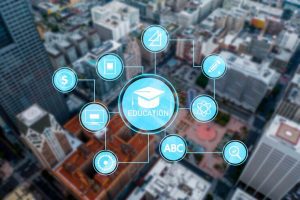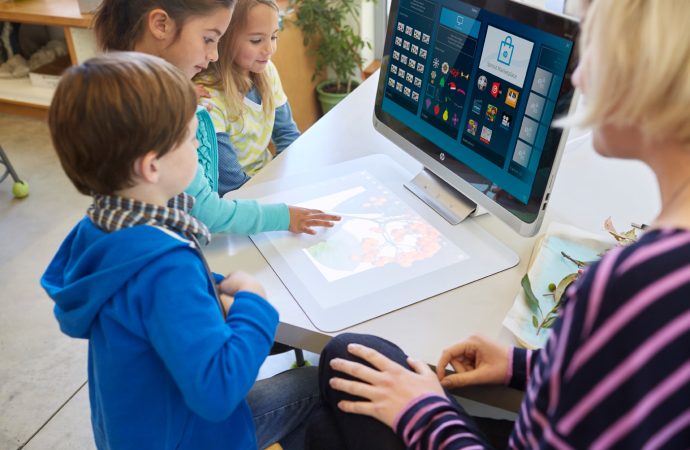Technology is changing education at a never-before-seen pace in a world that is becoming more and more digital. The educational landscape is always changing, from virtual classrooms and individualized instruction to tools powered by artificial intelligence. Keeping up with the most recent technological developments in education for 2024 can be essential for teachers, students, and
Technology is changing education at a never-before-seen pace in a world that is becoming more and more digital. The educational landscape is always changing, from virtual classrooms and individualized instruction to tools powered by artificial intelligence. Keeping up with the most recent technological developments in education for 2024 can be essential for teachers, students, and institutions to improve learning outcomes, give students the tools they need to succeed, and enhance learning experiences. The main technological advancements in education for 2024 are examined in this article together with their advantages, real-world case studies, and useful examples.
1. Artificial Intelligence (AI) in Education

Image by Freepik.com
Benefits
With its ability to facilitate automated administrative work, personalized learning, and more intelligent tutoring systems, artificial intelligence has become a disruptive force in education. AI can evaluate data about each individual student to customize training, spot comprehension gaps, and give immediate feedback. This implies that pupils get individualized support, which eventually raises their level of engagement and performance.
Case Study: Carnegie Learning’s AI-Driven Math Tutor
An AI-powered math teaching system created by educational resource provider Carnegie Learning is utilized in numerous American schools. Lessons are modified based on the platform’s real-time assessment of students’ performance. AI has the ability to improve and customize learning, as evidenced by research showing that schools implementing Carnegie’s approach witnessed a 20% boost in math student achievement.
Example
The application of chatbots in education is an illustration of AI in action. By promptly clearing up any ambiguities, these bots can provide a round-the-clock support system for students, reducing the need for extra resources and improving retention.
2. Mixed reality (AR) and virtual reality (VR)

Image by Freepik.com
Benefits
Virtual and augmented reality open up new ways for students to engage with learning materials. VR allows for immersive experiences that bring abstract concepts to life, like walking through ancient civilizations or exploring the human anatomy. AR, on the other hand, overlays digital content onto the real world, offering interactive learning opportunities that enhance students’ understanding and retention.
Case Study: VictoryVR’s Virtual Field Trips
VictoryVR has partnered with various schools to offer virtual field trips to places like space and the ocean floor. This has proven particularly beneficial for schools in remote areas or with limited resources. Students report feeling more engaged, and teachers observe better comprehension of complex topics through these immersive experiences.
Example
Imagine a science class studying the solar system. With AR, students can use their smartphones or tablets to see a model of the solar system come to life, making abstract astronomical concepts more tangible and memorable.
3. Blockchain for Secure Academic Credentials

Image by Freepik.com
Benefits
Blockchain technology in education is becoming more popular for securing and verifying academic records. With blockchain, educational institutions can store student credentials securely, minimizing the risk of fraud and making it easier for students to share their verified achievements with potential employers or other institutions.
Case Study: MIT’s Blockchain Diplomas
The Massachusetts Institute of Technology (MIT) was one of the first institutions to issue digital diplomas via blockchain. This secure and verifiable system allows graduates to share their credentials with employers globally without the risk of forgery. The initiative has since inspired other universities worldwide to adopt similar practices.
Example
Consider a graduate applying for a job abroad. Using blockchain, they can share their digital diploma with employers, who can easily verify its authenticity, streamlining the hiring process and eliminating the need for complex document verification.
4. Data Analytics for Personalized Learning
Benefits
Data analytics allows educators to assess students’ progress and identify areas where they may need additional support. Through learning analytics, schools can track student engagement and performance patterns, enabling a more data-driven approach to education. This helps create a personalized learning experience for each student, improving overall learning outcomes.
Case Study: Los Angeles Unified School District’s Use of Data Analytics
The Los Angeles Unified School District implemented a data analytics system to monitor student attendance, grades, and behavior. This data-driven approach helped identify at-risk students and provided tailored support, resulting in a 12% improvement in student retention rates.
Example
A high school teacher could use data analytics to analyze test results and determine which topics students find most challenging. The teacher can then adjust their lesson plans or provide targeted resources to address these difficulties, fostering a supportive and adaptive learning environment.
5. Gamification of Education

Image by Freepik.com
Benefits
Gamification incorporates elements of gaming—such as points, rewards, and competition—into educational settings to boost student engagement and motivation. Gamified learning platforms make learning fun, encouraging students to actively participate and persevere through challenges, which improves retention and overall enjoyment of the learning process.
Case Study: Kahoot! in Classrooms
Kahoot! is a gamified learning platform that allows teachers to create quizzes and interactive activities for students. Schools that use Kahoot! have reported increased student participation and enthusiasm, particularly in subjects like math and science. The platform’s engaging format has led to higher test scores and a deeper understanding of course materials.
Example
A history teacher could create a trivia game on Kahoot! about key historical events. Students participate in the quiz, earning points for correct answers. The competitive and interactive nature of the game not only makes learning fun but also reinforces their knowledge retention.
6. Cloud-Based Learning Platforms
Benefits
Cloud-based platforms enable students and educators to access educational materials anytime and from anywhere. This technology facilitates online learning, which became essential during the pandemic and continues to grow in relevance. Cloud platforms support collaborative learning, making it easier for students to work on projects together, regardless of their physical location.
Case Study: Google Classroom’s Role in Remote Learning
Google Classroom became a central tool for many schools worldwide during the COVID-19 pandemic, enabling seamless remote learning. Teachers could assign homework, provide feedback, and monitor progress in real time. Schools that adopted Google Classroom reported increased collaboration among students and streamlined communication with parents.
Example
A student working on a group project can collaborate with their peers through Google Docs, allowing all group members to contribute, edit, and discuss their work, regardless of their location. This flexibility fosters collaboration and makes it easier for students to manage their workloads.
7. Internet of Things (IoT) for Smart Campuses

Image by Freepik.com
Benefits
IoT technology connects various devices to create “smart” classrooms and campuses, where everything from lighting to temperature is optimized for comfort. IoT also enhances security, automates attendance tracking, and provides data on student movement and engagement, helping to create safer and more efficient learning environments.
Case Study: University of Michigan’s Smart Campus Initiatives
The University of Michigan is implementing IoT to make its campus smarter and more energy-efficient. Using sensors, they have optimized lighting, heating, and cooling systems to reduce costs and environmental impact. Students benefit from improved comfort, and the university has noted substantial savings.
Example
In a smart classroom, sensors can detect when the room is empty and automatically turn off lights and lower the thermostat. This not only saves energy but also contributes to a comfortable learning environment.
8. Mobile Learning (M-Learning)
Benefits
With the widespread use of smartphones and tablets, mobile learning allows students to access educational materials on the go. M-learning provides flexibility and convenience, enabling students to learn at their own pace and making education accessible to those in remote or underserved areas.
Case Study: Duolingo’s Impact on Language Learning
Duolingo, a language-learning app, has made learning new languages more accessible and engaging. By leveraging gamification and a mobile-friendly interface, Duolingo has helped millions of users improve their language skills worldwide. The app’s success has proven that M-learning can be a powerful tool for making education more accessible.
Example
A student interested in learning French can use an app like Duolingo to practice vocabulary and grammar during their daily commute, transforming downtime into productive learning sessions.
9. Video-Based Learning and Microlearning

Image by Freepik.com
Benefits
Video-based learning and microlearning cater to modern learners’ short attention spans. These formats allow students to absorb information in bite-sized, easily digestible segments, which can be particularly effective for complex subjects. Video content is also highly engaging and has been shown to improve information retention.
Case Study: Edmentum’s Success with Video Tutorials
Final Thought
Augm and Virtual Reality (VR)A significant shift towards individualized, immersive, and data-driven learning experiences is evident in the digital trends in education for 2024. AI, blockchain, IoT, and gamified platforms are just a few of the technologies that provide previously unheard-of advantages that enhance results, accessibility, and engagement. We may look forward to a future where education is more accessible and flexible, assisting students all around the world in realizing their full potential, as long as educators and institutions keep implementing these tools.
These developments will probably get even better and more widely available in the upcoming years, guaranteeing that education will continue to be a driving force for both professional and personal development in a world that is becoming more and more digital.
















